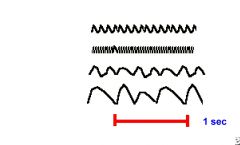![]()
![]()
![]()
Use LEFT and RIGHT arrow keys to navigate between flashcards;
Use UP and DOWN arrow keys to flip the card;
H to show hint;
A reads text to speech;
32 Cards in this Set
- Front
- Back

|

|
|
|
How many hertz is a "Beta" waveform
|
15-30
|
|
|
How many hertz is a "Alpha" waveform
|
9-14
|
|
|
How many hertz is a "Theta" waveform
|
4-8
|
|
|
How many hertz is a "Delta" waveform
|
1-3
|
|
|
List in sequence "fastest to slowest" the EEG waveforms
|
Beta>Alpha>Theta>Delta
|
|
|
-Awake, normal, alert, consciousness
What EEG waveform does this describe? |
Beta
|
|
|
-Relaxed, calm, meditation, creative visualisation
What EEG waveform does this describe? |
Alpha
|
|
|
-Deep relaxation and mediation, problem solving
What EEG waveform does this describe? |
Theta
|
|
|
Deep, Dreamless sleep
What EEG waveform does this describe? |
Delta
|
|
|
In the absence of a pathologic process, how are EEG amplitude and frequency related?
|
Inversely related
|
|
|
A simultaneous decrease in EEG amplitude and frequency may indicate what?
|
ischemia, anoxia, or excessive hypnosis
|
|
|
A simultaneous increase in EEG amplitude and frequency may indicate what?
|
seizure activity or artifact
|
|
|
Type of CNS monitoring where "auditory stimuli travels to the auditory nerve and then on to the cerebral cortex"
|
"auditory evoked potentials"
|
|
|
This type of CNS monitoring is ideal for Cardiac surgery b/c there is very little change in the signal as the temperature of the body changes
|
auditory evoked potentials
|
|
|
Defined as a doppler wave transmitted through the temporal bone to the large vessels
|
Transcranial doppler ultrasonography
|
|
|
What artery is viewed when using a transcranial doppler signal
|
The middle Cerebral Artery
|
|
|
What EEG monitoring technique can be used to detect emboli
|
Transcranial Doppler
|
|
|
What EEG monitoring technique can be used to detect improper head position prior to the start of cardiopulmonary bypass
|
Transcranial Doppler
|
|
|
What EEG monitoring technique can be used to detect if the Aortic perfusion cannula has not been properly placed
|
Transcranial Doppler
|
|
|
An oximeter probe that is inserted into the Jugular venous system and it measures continuous cerebral oxygen saturation
|
Jugular Bulb Oximetry
|
|
|
What are the 2 major limitations to Jugular Bulb Oximetry
|
1. the vascularity of the skull is extremely varied and placement of the catheter may not accurately reflect vascular return
2. Low flow states may give inaccurate measures |
|
|
Measures intravascular hgb concentrations in the skull, and is the most rapidly growing method of monitoring d/t its ease of use and accuracy
|
Cerebral Oximetry
|
|
|
T or F
The human skull is translucent to infrared light |
True
|
|
|
May be used during nonpulsatile cardiopulmonary bypass and even circulatory arrest
|
Cerebral Oximetry
|
|
|
________ is primarily used to quantify change, However a value below 50 is associated with?
|
cerebral oximetry
cognitive deficits |
|
|
Cerebral Oximetry is good choice to help measure abrupt changes during what procedure
|
carotid endarterectomy
|
|
|
When should Cerebral Oximetry be instituted?
|
once the pt enters the OR to establish a baseline
|
|
|
A simple change such as turning the head to place a PA catheter could have what effects on the cerebral oximetry reading
|
will cause large decreases in cerebral oximetry reading
|
|
|
This type of monitoring is the weighted sum of electroencephalographic subparameters derived to give a single value
|
BIS monitoring
|
|
|
on the BIS scale-0 equates to ________, and 100 equates to ______
|
silent EEG and 100 equate a fully awake patient
|
|
|
What BIS value indicates an appropriate level of sedation for GA
|
40-60
|

